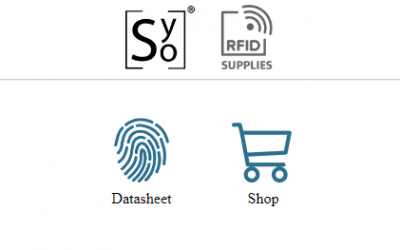The most significant ongoing expense in every RFID deployment is the cost of the tags applied to the products. During ROI calculations, teams mostly rely on their solution integrators and tag vendors to provide a rough estimate for the costing.
In vertically integrated organisations, the production team often has to bear the cost of the RFID tag as part of the trims, while many of the initial benefits are in store operations, a different cost centre. We have seen many cases with great potential and a significant return on investment for retailers and brand owners, where internal teams kept reverting to the cost of the tag as an inhibitor to proceed with the project. In other cases the complexity to tag all products at source is underestimated and left too late, putting the project schedule in jeopardy.
Components Impacting the Cost of an RFID tag
Several factors impact the cost of the finished RFID Tag:
- IC cost incl. delivery to the assembly house
- Antenna cost incl. delivery to the assembly house
- Tag assembly (incl. cost such as ACP, labour and depreciation of equipment)
- Tooling
- Converting of the RFID tag into a wet inlay or paper face sticker
- Sampling
- Yield loss
- Shipping of tags to service bureau locations
- Encoding of the RFID tag
The cost of non-RFID labels is an existing expenditure that needs to be added. Often these services are provided by service bureaus and include:
- Printing of non-variable data or branding
- Converting paper and board into hangtags incl. over-lamination and other processes
- Variable Data Management
- Variable Data Print
- Handling, distribution and delivery to garment manufacturers
Engage Tag and IC Vendors Early
The cost of the IC, the chip on the RFID tag, is a significant portion of the cost. Companies with plans to implement RFID at scale consume several hundred million ICs every year. Chip vendors won’t disclose pricing or sell chips to brand owners or retailers. Aligning with these semiconductor companies will help them to gain visibility into projects and volumes. In exchange, they may provide inlay vendors with dedicated project pricing for your project. You can also request supply assurances, offering protection from a disruption in the supply chain or supply shortages caused by unpredicted volume growth.
Minimise Complexity
Most RFID projects facilitate standard inlay sizes with 50×30 or 70x14mm. Vendors produce these formats at scale, products in these formats are readily available from most vendors and are usually available with reasonably short lead times.
Smaller programs tend to require custom inlay sizes. Custom sizes and delivery format often lead to higher complexity, longer lead times and high sensitivity to disruptions in the supply chain. Substitution of custom formats requires more preparation, increases the cost of sampling and qualification, and is often associated with longer lead times.
We mentioned above the cost of sampling and tooling. Especially in smaller programs, this initial cost will need to be absorbed by smaller delivery quantities, increasing the running cost of the program unnecessarily.
Get Professional Help
Vendors will have different motivations for recommending specific products, tags, manufacturers or ICs. These recommendations may not always be independent and solely based on the needs and requirements of your RFID program. Many service bureaus also double as solution providers. They supply software, hardware, and integration with IT systems. Naturally, solution integrators, as well as service bureaus, are protective and strive to maximise their revenue share. The competitive nature of this business can lead to biased recommendations from the parties.
Sourcing agents are best qualified to help you with the assessment of recommendations received. Sourcing agents can help you to navigate the complex value chain from IC supply, tag assembly and converting. Sourcing agents operate with well-respected industry experts and will provide expertise to your project and sourcing teams. Professional help will ensure you will make all decisions in your best business interest; you will have full vertical visibility into the supply chain, ensure quality, appropriate supply levels, and minimise the incremental tag cost.
Complexity creates unnecessary cost
After years of growth, standard products are manufactured at scale. Standard RFID products can be priced most competitive and are available globally.
Develop your strategy
Tag manufacturers or assembly houses supply many service bureaus and other tag resellers. Very few companies produce tags in-house without the use of subcontractors or OEM. Even companies that manufacture tags, usually outsource parts, such as antennas, to OEM and may subcontract manufacturing for certain markets or customers.
Minimising the effect of margin stacking by negotiating volume deals with the tag manufacturer will ensure you receive the most competitive price for your program. It will also assure the correct implementation of multi-sourcing strategies and that different factories and entities manufacture the products. Mandating suppliers to your service bureau provides you with maximum control over supply, pricing and performance.
Manage Performance
One of the value service bureaus add in RFID deployments is to monitor the performance of their chosen vendors and their products. They warrant the quality of the finished labels delivered and distribute the material to factories.
The first step to manage performance is to decide on a test protocol that delivers meaningful, repeatable results. Your applications will determine the performance requirements, that will be used to qualify products for our program. Some reputable institutions have established a set of criteria for applications, e.g. the European EPC Competence Center (EECC) or RFID Lab at Auburn University with the ARC Program.
Supplier Management
The yield of the RFID tags supplied by manufacturers will impact production at the service bureau. Consistent, high-quality tags should lead to less wastage while rolls with faulty tags may increase the cost. Monitoring yields will ensure service bureau operations can be efficient.
In the highly automated production lines, tag manufacturers produce consistent product quality. Procedures to regularly test sample batches can help to ensure applications will continue to operate with the desired read performance needed to deliver on the ROI of the underlying business process.
RFID is a fast-growing industry with many established and new vendors, both enjoying exponential growth. However, large RFID programs can still cause a significant shift in the machine loading of factories, availability of ICs and antenna supply. Monitoring shifts in the global RFID market allows deploying strategies to counter any squeeze on supply early and to ensure the supply chain won’t be affected.
Professional sourcing agents will provide visibility into the global RFID market and help to identify and mitigate:
- Disruptions in the supply of ICs and antennas
- Factory and machine loading
- Stock levels of semi-finished and finished products
- Quality issues of manufacturers

























